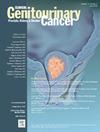单药维多汀治疗晚期尿路上皮癌的实际疗效。
IF 2.3
3区 医学
Q3 ONCOLOGY
引用次数: 0
摘要
背景:Enfortumab vedotin (EV)是一种连接素-4导向抗体和微管抑制剂偶联物,适用于既往接受过铂类化疗和PD-1/L1抑制剂或不符合含顺铂方案且至少接受过1种既往治疗的转移性尿路上皮癌(mUC)患者。EV也适用于与派姆单抗联合一线治疗。然而,基于治疗线和既往治疗影响的EV的实际有效性尚不清楚。方法:本回顾性研究利用全国Flatiron Health电子健康记录(EHR)衍生的去识别数据库。在2019年12月18日(FDA加速批准日期)之后接受二线或以上单药EV治疗的晚期、复发性或上尿路或下尿路mUC患者被纳入研究。排除无一线治疗记录或在确诊后90天内无接触证据的患者。基于治疗线和既往铂类化疗和PD-1/L1抑制剂,使用Kaplan-Meier生存估计及其95%置信区间分析下一次治疗时间(TTNT)和总生存期(OS)。结果:2020年1月17日至2022年9月30日期间,6566例mUC患者接受了全身治疗,其中431例接受了EV治疗。EV单药治疗通过不同的线进行(N = 371):第二(157),第三(132),第四(62)和第五(20)。约22%的患者既往接受过铂类药物治疗,48%的患者既往接受过PD-1/L1抑制剂治疗。中位TTNT和OS因治疗线而异,既往铂暴露的患者通常显示更长的TTNT和OS,特别是在四线治疗中接受EV的患者。结论:无论之前是否接受过铂类化疗和PD-1/L1抑制剂或治疗方案,EV对mUC患者都有疗效。虽然只是假设,但这些发现为临床实践中的患者咨询、预后和治疗决策提供了有价值的见解。本文章由计算机程序翻译,如有差异,请以英文原文为准。
Real-world Effectiveness of Single-Agent Enfortumab Vedotin in Patients With Advanced Urothelial Carcinoma
Background
Enfortumab vedotin (EV) is a nectin-4-directed antibody and microtubule inhibitor conjugate indicated for patients with metastatic urothelial carcinoma (mUC) who have received prior platinum-based chemotherapy and PD-1/L1 inhibitors or are ineligible for cisplatin-containing regimens and have undergone at least 1 prior line of therapy. EV is also indicated in combination with pembrolizumab in the first-line setting. However, real-world effectiveness of EV based on treatment line and impact of prior therapy remains unclear.
Methods
This retrospective study utilized the nationwide Flatiron Health electronic health record (EHR)-derived de-identified database. Patients with advanced, recurrent, or mUC of upper or lower urinary tract who received single-agent EV in the second-line or beyond after December 18, 2019 (FDA accelerated approval date), were included. Patients without documentation of first-line therapy or without evidence of contact for 90 days from mUC diagnosis were excluded. Time to next therapy (TTNT) and overall survival (OS) were analyzed based on treatment line and prior platinum-based chemotherapy and PD-1/L1 inhibitors using Kaplan-Meier survival estimates and its 95% confidence interval.
Results
Between January 17, 2020, and September 30, 2022, 6566 patients with mUC received systemic treatment, with 431 receiving EV. EV monotherapy was administered across various lines (N = 371): second (157), third (132), fourth (62), and fifth (20). Approximately 22% of patients had prior platinum-based therapy, and 48% had prior PD-1/L1 inhibitors. Median TTNT and OS varied across treatment lines, with patients with prior platinum exposure generally showing longer TTNT and OS, notably in those receiving EV in the fourth-line setting.
Conclusions
EV demonstrates efficacy in patients with mUC regardless of prior receipt of platinum-based chemotherapy and PD-1/L1 inhibitors or treatment line. While only hypothesis-generating, these findings provide valuable insights for patient counseling, prognostication, and therapeutic decision-making in clinical practice.
求助全文
通过发布文献求助,成功后即可免费获取论文全文。
去求助
来源期刊

Clinical genitourinary cancer
医学-泌尿学与肾脏学
CiteScore
5.20
自引率
6.20%
发文量
201
审稿时长
54 days
期刊介绍:
Clinical Genitourinary Cancer is a peer-reviewed journal that publishes original articles describing various aspects of clinical and translational research in genitourinary cancers. Clinical Genitourinary Cancer is devoted to articles on detection, diagnosis, prevention, and treatment of genitourinary cancers. The main emphasis is on recent scientific developments in all areas related to genitourinary malignancies. Specific areas of interest include clinical research and mechanistic approaches; drug sensitivity and resistance; gene and antisense therapy; pathology, markers, and prognostic indicators; chemoprevention strategies; multimodality therapy; and integration of various approaches.
 求助内容:
求助内容: 应助结果提醒方式:
应助结果提醒方式:


